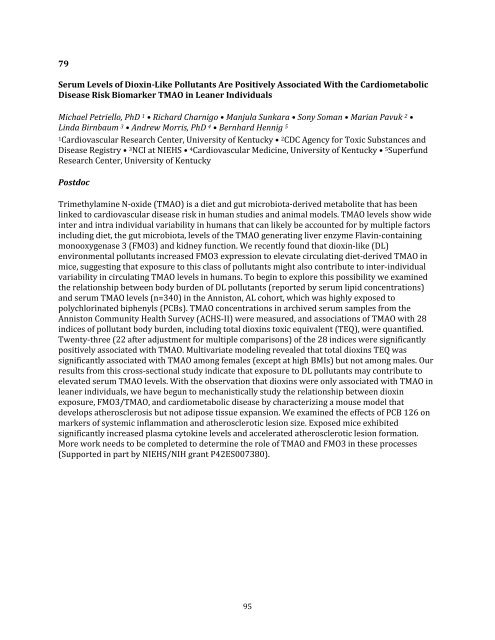2017 Cardiovascular Research Day Abstract Book
You also want an ePaper? Increase the reach of your titles
YUMPU automatically turns print PDFs into web optimized ePapers that Google loves.
79<br />
Serum Levels of Dioxin-Like Pollutants Are Positively Associated With the Cardiometabolic<br />
Disease Risk Biomarker TMAO in Leaner Individuals<br />
Michael Petriello, PhD 1 • Richard Charnigo • Manjula Sunkara • Sony Soman • Marian Pavuk 2 •<br />
Linda Birnbaum 3 • Andrew Morris, PhD 4 • Bernhard Hennig 5<br />
1<strong>Cardiovascular</strong> <strong>Research</strong> Center, University of Kentucky • 2 CDC Agency for Toxic Substances and<br />
Disease Registry • 3 NCI at NIEHS • 4 <strong>Cardiovascular</strong> Medicine, University of Kentucky • 5 Superfund<br />
<strong>Research</strong> Center, University of Kentucky<br />
Postdoc<br />
Trimethylamine N-oxide (TMAO) is a diet and gut microbiota-derived metabolite that has been<br />
linked to cardiovascular disease risk in human studies and animal models. TMAO levels show wide<br />
inter and intra individual variability in humans that can likely be accounted for by multiple factors<br />
including diet, the gut microbiota, levels of the TMAO generating liver enzyme Flavin-containing<br />
monooxygenase 3 (FMO3) and kidney function. We recently found that dioxin-like (DL)<br />
environmental pollutants increased FMO3 expression to elevate circulating diet-derived TMAO in<br />
mice, suggesting that exposure to this class of pollutants might also contribute to inter-individual<br />
variability in circulating TMAO levels in humans. To begin to explore this possibility we examined<br />
the relationship between body burden of DL pollutants (reported by serum lipid concentrations)<br />
and serum TMAO levels (n=340) in the Anniston, AL cohort, which was highly exposed to<br />
polychlorinated biphenyls (PCBs). TMAO concentrations in archived serum samples from the<br />
Anniston Community Health Survey (ACHS-II) were measured, and associations of TMAO with 28<br />
indices of pollutant body burden, including total dioxins toxic equivalent (TEQ), were quantified.<br />
Twenty-three (22 after adjustment for multiple comparisons) of the 28 indices were significantly<br />
positively associated with TMAO. Multivariate modeling revealed that total dioxins TEQ was<br />
significantly associated with TMAO among females (except at high BMIs) but not among males. Our<br />
results from this cross-sectional study indicate that exposure to DL pollutants may contribute to<br />
elevated serum TMAO levels. With the observation that dioxins were only associated with TMAO in<br />
leaner individuals, we have begun to mechanistically study the relationship between dioxin<br />
exposure, FMO3/TMAO, and cardiometabolic disease by characterizing a mouse model that<br />
develops atherosclerosis but not adipose tissue expansion. We examined the effects of PCB 126 on<br />
markers of systemic inflammation and atherosclerotic lesion size. Exposed mice exhibited<br />
significantly increased plasma cytokine levels and accelerated atherosclerotic lesion formation.<br />
More work needs to be completed to determine the role of TMAO and FMO3 in these processes<br />
(Supported in part by NIEHS/NIH grant P42ES007380).<br />
95


